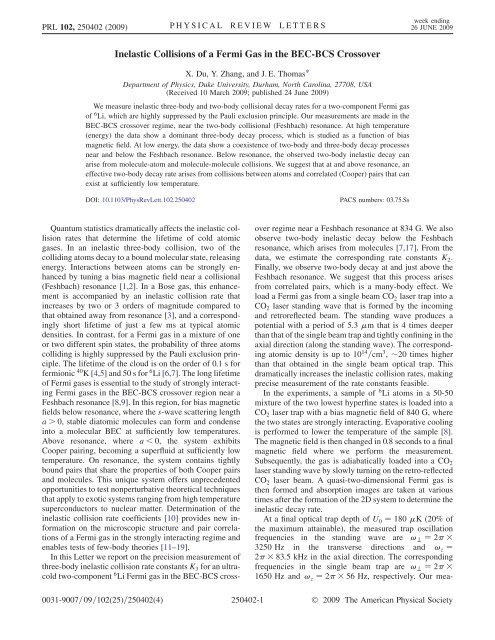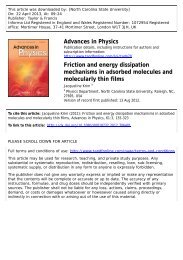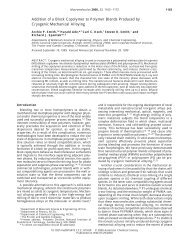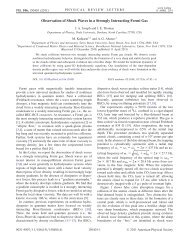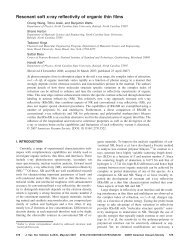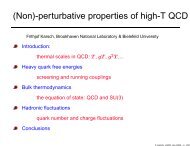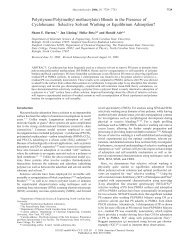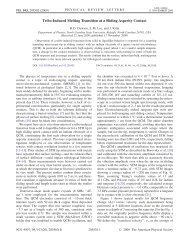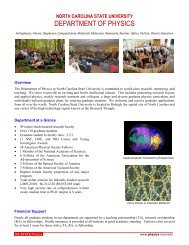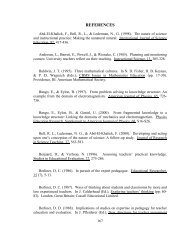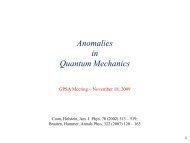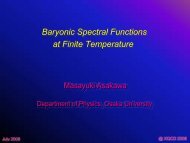Phys. Rev. Lett. 102, 250402 (2009): Inelastic Collisions of a Fermi ...
Phys. Rev. Lett. 102, 250402 (2009): Inelastic Collisions of a Fermi ...
Phys. Rev. Lett. 102, 250402 (2009): Inelastic Collisions of a Fermi ...
You also want an ePaper? Increase the reach of your titles
YUMPU automatically turns print PDFs into web optimized ePapers that Google loves.
PRL <strong>102</strong>, <strong>250402</strong> (<strong>2009</strong>) PHYSICAL REVIEW LETTERS<br />
week ending<br />
26 JUNE <strong>2009</strong><br />
<strong>Inelastic</strong> <strong>Collisions</strong> <strong>of</strong> a <strong>Fermi</strong> Gas in the BEC-BCS Crossover<br />
X. Du, Y. Zhang, and J. E. Thomas*<br />
Department <strong>of</strong> <strong>Phys</strong>ics, Duke University, Durham, North Carolina, 27708, USA<br />
(Received 10 March <strong>2009</strong>; published 24 June <strong>2009</strong>)<br />
We measure inelastic three-body and two-body collisional decay rates for a two-component <strong>Fermi</strong> gas<br />
<strong>of</strong> 6 Li, which are highly suppressed by the Pauli exclusion principle. Our measurements are made in the<br />
BEC-BCS crossover regime, near the two-body collisional (Feshbach) resonance. At high temperature<br />
(energy) the data show a dominant three-body decay process, which is studied as a function <strong>of</strong> bias<br />
magnetic field. At low energy, the data show a coexistence <strong>of</strong> two-body and three-body decay processes<br />
near and below the Feshbach resonance. Below resonance, the observed two-body inelastic decay can<br />
arise from molecule-atom and molecule-molecule collisions. We suggest that at and above resonance, an<br />
effective two-body decay rate arises from collisions between atoms and correlated (Cooper) pairs that can<br />
exist at sufficiently low temperature.<br />
DOI: 10.1103/<strong>Phys</strong><strong>Rev</strong><strong>Lett</strong>.<strong>102</strong>.<strong>250402</strong><br />
PACS numbers: 03.75.Ss<br />
Quantum statistics dramatically affects the inelastic collision<br />
rates that determine the lifetime <strong>of</strong> cold atomic<br />
gases. In an inelastic three-body collision, two <strong>of</strong> the<br />
colliding atoms decay to a bound molecular state, releasing<br />
energy. Interactions between atoms can be strongly enhanced<br />
by tuning a bias magnetic field near a collisional<br />
(Feshbach) resonance [1,2]. In a Bose gas, this enhancement<br />
is accompanied by an inelastic collision rate that<br />
increases by two or 3 orders <strong>of</strong> magnitude compared to<br />
that obtained away from resonance [3], and a correspondingly<br />
short lifetime <strong>of</strong> just a few ms at typical atomic<br />
densities. In contrast, for a <strong>Fermi</strong> gas in a mixture <strong>of</strong> one<br />
or two different spin states, the probability <strong>of</strong> three atoms<br />
colliding is highly suppressed by the Pauli exclusion principle.<br />
The lifetime <strong>of</strong> the cloud is on the order <strong>of</strong> 0.1 s for<br />
fermionic 40 K [4,5] and 50 s for 6 Li [6,7]. The long lifetime<br />
<strong>of</strong> <strong>Fermi</strong> gases is essential to the study <strong>of</strong> strongly interacting<br />
<strong>Fermi</strong> gases in the BEC-BCS crossover region near a<br />
Feshbach resonance [8,9]. In this region, for bias magnetic<br />
fields below resonance, where the s-wave scattering length<br />
a>0, stable diatomic molecules can form and condense<br />
into a molecular BEC at sufficiently low temperatures.<br />
Above resonance, where a
PRL <strong>102</strong>, <strong>250402</strong> (<strong>2009</strong>) PHYSICAL REVIEW LETTERS<br />
week ending<br />
26 JUNE <strong>2009</strong><br />
surements indicate very good standing wave alignment, as<br />
the transverse frequency is nearly twice that <strong>of</strong> the single<br />
beam trap, as expected.<br />
The total energy <strong>of</strong> the gas obeys the virial theorem [20]<br />
when the bias magnetic field is tuned to a broad Feshbach<br />
resonance, where the <strong>Fermi</strong> gas is unitary. Since the trap<br />
depth is large compared to the energy <strong>of</strong> the cloud, the<br />
confining potential U is approximately harmonic. Then the<br />
total energy is E ¼ 2hUi ¼E z þ E , where E z is the axial<br />
energy and E is the transverse energy, referred to the trap<br />
minimum. We determine only the transverse energy E ¼<br />
2m! 2 hx2 i, by measuring the mean square transverse cloud<br />
size hx 2 i. For reference, the transverse energy for the<br />
ground state <strong>of</strong> an ideal two dimensional <strong>Fermi</strong> gas is<br />
E I ¼ 2 3 E F, where E F is the transverse <strong>Fermi</strong> energy,<br />
E F ¼ @! Ns<br />
1=2 . Here m is atomic mass <strong>of</strong> 6 Li and N s is<br />
the total atom number in one site. For our experiments in<br />
the unitary gas, we measure E =E F 1:8 with N s ¼<br />
2600 and E =E F 0:7 with N s ¼ 1600. If the 2D unitary<br />
gas has the same effective mass as the 3D<br />
p<br />
case,<br />
ffiffiffiffiffiffiffiffiffiffiffiffiffi<br />
the 2D<br />
ground state transverse energy would be 2E F 1 þ =3 ’<br />
0:42E F , using ¼ 0:60 [21].<br />
In general, for magnetic fields away from resonance<br />
where the scattering length is finite, the total energy is<br />
dependent on the scattering length [22]. In this case, we<br />
measure the number-independent mean square transverse<br />
cloud size hx 2 i=x 2 F , where x2 F is defined by 2m!2 x2 F <br />
E F . For an ideal gas in the ground state, we note that<br />
hx 2 0 i¼2 3 x2 F .<br />
We measure inelastic collision rates by measuring the<br />
time dependence <strong>of</strong> the atom number and the radial cloud<br />
size. We observe that a 50-50 mixture <strong>of</strong> both spin states is<br />
maintained within 5%. In this case, the atom number N as a<br />
function <strong>of</strong> time can be written as [3]<br />
dN<br />
dt<br />
¼ N Z K 2 n 2 d 3 x<br />
Z<br />
K3 n 3 d 3 x; (1)<br />
in the transverse directions, z ¼ð @<br />
m! z<br />
Þ 1=2 is axial width<br />
for the ground state (along the standing wave), and ! z is<br />
the corresponding axial trap frequency. The transverse<br />
width is determined by releasing the cloud and imaging,<br />
using the measured trap frequencies and assuming hydrodynamic<br />
expansion to determine the scale factor [8].<br />
In our experiments, NðzÞ varies as a Gaussian distribution<br />
function <strong>of</strong> z with width L z over the whole cloud in the<br />
axial direction. Strictly speaking, , z and ! z also vary<br />
with z since the depth UðzÞ <strong>of</strong> the potential for a site at z is a<br />
Lorentzian function <strong>of</strong> z. However, we measure a restricted<br />
part <strong>of</strong> the cloud from z ¼ 0:83L z to z ¼ 0:83L z over<br />
which UðzÞ varies less than 10%. Since the central sites<br />
with higher density lose atoms faster than the edge sites at<br />
lower density, the densities and hence the loss rates for<br />
different sites tend to approach similar values. For this<br />
reason, we assume for simplicity that , z , and ! z are<br />
spatially constant.<br />
Integrating the atomic density over each well and<br />
then over the restricted region <strong>of</strong> the cloud, we obtain<br />
from Eq. (1)<br />
dN c<br />
dt<br />
¼ N c 2 K 2<br />
N 2 c<br />
2 ðtÞ z<br />
3 K 3<br />
4 ; (3)<br />
ðtÞ2 z<br />
where N c is total number <strong>of</strong> atoms in the restricted region.<br />
If we assume that all <strong>of</strong> the atoms are in the ground axial<br />
vibrational state, we obtain 2 ¼ ffiffi 2 p<br />
2<br />
3 3=2 and 3 ¼<br />
p2ffiffi 3<br />
3 . Note that ðtÞ is a function <strong>of</strong> time since heating<br />
leads to an increase in temperature and hence the width <strong>of</strong><br />
the cloud during the atom loss process. Typically 2 <br />
ðtÞ can<br />
be fit well to exponential curves, / expðtÞ, Fig. 1 inset.<br />
Note that at the highest energies used in our experiments,<br />
a significant fraction <strong>of</strong> atoms can occupy excited<br />
axial states. For the higher energy experiments, where<br />
E =E F ’ 2, if we assume a Maxwell-Boltzmann distribution<br />
for an ideal gas, we find that 50% <strong>of</strong> the atoms are in<br />
N 3 c<br />
where n is the total atomic density. On the right side, the<br />
first term arises from background collisions with a densityindependent<br />
rate (1= ¼ 64 s for our trap). The second<br />
term arises from loss due to two-body inelastic collisions<br />
with a rate coefficient K 2 , while the third term arises from<br />
loss due to three-body collisions with a rate coefficient K 3 .<br />
For the conditions <strong>of</strong> our experiments, where<br />
E F =@! z ’ 1:5, the ground axial state contains 90% <strong>of</strong><br />
the atoms for an ideal <strong>Fermi</strong> gas at zero temperature. For<br />
simplicity, we assume that the 2D <strong>Fermi</strong> gas is primarily in<br />
the ground axial state <strong>of</strong> a single site for our experiments at<br />
the lowest energies. Then, the atomic density is<br />
nð; zÞ ¼ 2<br />
3=2<br />
NðzÞ<br />
2 z<br />
<br />
1<br />
2<br />
2 <br />
<br />
exp<br />
z 2<br />
2 z<br />
<br />
; (2)<br />
for 0 . Here, NðzÞ is the atom number in the site<br />
at position z. is the transverse width for a fit <strong>of</strong> a<br />
Thomas-<strong>Fermi</strong> distribution to the atomic density pr<strong>of</strong>ile<br />
<strong>250402</strong>-2<br />
FIG. 1 (color online). Atom number versus time. Data were<br />
taken at 823 G and E =E F ¼ 1:8. N is total atom number and<br />
N 0 is initial atom number in the observed region <strong>of</strong> the cloud.<br />
Blue dots: Experimental data; red solid curve: Three-body decay<br />
fit; green dashed line: Two-body decay fit. Inset shows the<br />
increase in the mean square transverse width versus time, due<br />
to heating.
PRL <strong>102</strong>, <strong>250402</strong> (<strong>2009</strong>) PHYSICAL REVIEW LETTERS<br />
week ending<br />
26 JUNE <strong>2009</strong><br />
TABLE I. Three-body decay coefficient K 3 . Here, K 3 is determined<br />
from Eq. (3) without the systematic correction for finite<br />
temperature (see text). BðGÞ is the bias magnetic field in gauss.<br />
Scattering length a is calculated using the formula in [23]. T F is<br />
the transverse <strong>Fermi</strong> temperature for an ideal gas. Error bars are<br />
statistical.<br />
FIG. 2 (color online). Three-body inelastic collision rate coefficient<br />
K 3 versus atomic density for E =E F ¼ 1:8. Blue dots:<br />
Experimental data. Error bars indicate statistical errors; Red<br />
dashed line: Fit to the data with K 3 ¼ð8:4 1:0Þ<br />
10 28 cm 6 =s. Bars denote statistical error.<br />
B(G) að10 3 a 0 Þ T F ðKÞ 1=k F a hx 2 i=x 2 F<br />
K 3ð10 28 cm 6 =sÞ<br />
780 6.4 8.7 0.20 2.1 17.3(3.2)<br />
800 11 8.7 0.12 2.0 10.8(4.0)<br />
823 36 9.9 0.03 1.8 8.4(1.0)<br />
848 32 9.0 0:04 1.9 4.1(0.5)<br />
877 11 9.4 0:11 1.9 3.5(0.9)<br />
905 7:4 8.7 0:17 1.8 2.3(0.9)<br />
934 5:6 8.7 0:23 1.8 1.9(0.7)<br />
1174 2:7 9.3 0:46 1.8 0.45(0.23)<br />
<strong>250402</strong>-3<br />
the ground state, and the increased axial width reduces 3<br />
by a factor <strong>of</strong> 0.7 and 2 by a factor <strong>of</strong> 0.8. As the gas heats,<br />
E =E F ’ 2 increases up to 2.5 (see Fig. 1 inset), these<br />
correction factors change to 0.6 and 0.7, respectively. As<br />
the estimated changes in these systematic corrections introduce<br />
an error that is comparable to or smaller than the<br />
statistical uncertainty in our data, we neglect them in our<br />
initial analysis and assume that the axial width is time<br />
independent and equal to the ground state value. The rate<br />
constants determined from the fits can then be increased by<br />
the appropriate factor.<br />
In the first set <strong>of</strong> experiments, we have measured atom<br />
number as a function <strong>of</strong> time in the unitary regime at<br />
823 G, as shown in Fig. 1. The trap depth is set at 20%<br />
<strong>of</strong> the maximum attainable by reducing the laser intensity.<br />
The measured transverse energy <strong>of</strong> the cloud is E =E F ¼<br />
1:8. We observe a significant ( > 60%) loss <strong>of</strong> the atoms in<br />
20 sec. The data are fit with Eq. (3). We find that a threebody<br />
decay curve fits the data very well while a two-body<br />
decay curve increases 2 by a factor <strong>of</strong> 10. This indicates<br />
that three-body inelastic collisions play a dominant role in<br />
the atom loss.<br />
Figure 2 shows the inelastic decay rate coefficient K 3 as<br />
a function <strong>of</strong> atomic density, at 823 G, for E =E F ¼ 1:8.<br />
The atomic density is varied by varying the final trap depth.<br />
Data are fit to three-body decay curves, from which we<br />
determine K 3 . A constant value <strong>of</strong> K 3 over a factor <strong>of</strong> 10 in<br />
atomic density indicates the atom loss is indeed a threebody<br />
decay process. By fitting all <strong>of</strong> the data with the same<br />
K 3 , we obtain K 3 ¼ð8:4 1:0Þ10 28 cm 6 =s.<br />
Table I shows K 3 as a function <strong>of</strong> magnetic field for<br />
hx 2 i=x 2 F<br />
1:8, which corresponds to the transverse energy<br />
E =E F ¼ 1:8 at unitarity. In the table, k F ¼<br />
ð2mE F Þ 1=2 =@ is the two-dimensional <strong>Fermi</strong> wave vector<br />
for an ideal gas at the trap center and a is the s-wave<br />
scattering length. We fit our data on the BCS side <strong>of</strong> the<br />
Feshbach resonance, a
PRL <strong>102</strong>, <strong>250402</strong> (<strong>2009</strong>) PHYSICAL REVIEW LETTERS<br />
week ending<br />
26 JUNE <strong>2009</strong><br />
resonance at B ¼ 877 G, we find K 3 ¼ 3:5 0:9 <br />
10 28 cm 6 =s at hx 2 i=x 2 F ¼ 1:9 and K 3 ¼ 1:9 0:3 <br />
10 28 cm 6 =s at hx 2 i=x 2 F ¼ 0:8. In this case, K 3ðhx 2 i=<br />
x 2 F ¼ 1:9Þ=K 3ðhx 2 i=x 2 F<br />
¼ 0:8Þ ¼1:8 0:6, while the<br />
ratio <strong>of</strong> the mean square widths is 1:9=0:8 ¼ 2:4. For<br />
data taken below resonance at a magnetic field <strong>of</strong> 780 G<br />
at hx 2 i=x 2 F ¼ 2:1, we find K 3 ¼ð17:3 3:2Þ<br />
10 28 cm 6 =s. Athx 2 i=x 2 F ¼ 0:9, we obtain K 3 ¼ð9:4 <br />
3:1Þ10 28 cm 6 =s. Then K 3 ðhx 2 i=x 2 F ¼ 1:8Þ=<br />
K 3 ðhx 2 i=x 2 F<br />
¼ 0:9Þ ¼1:8 0:7, while the ratio <strong>of</strong> the<br />
mean square widths is 2:1=0:9 ¼ 2:3, again consistent<br />
with linear scaling with energy [14].<br />
We observe two-body loss rates at low energy<br />
hx 2 i=x 2 F<br />
1, in addition to the three-body rate. In contrast,<br />
at high energy, hx 2 i=x 2 F ’ 2, we find K 2 ¼ 0. At<br />
780 G we obtain K 2 ¼ð0:57 0:22Þ10 14 cm 3 =s at<br />
hx 2 i=x 2 F<br />
¼ 0:9. On the BEC side <strong>of</strong> the Feshbach resonance,<br />
we expect that two-body inelastic collisions arise<br />
from molecule-atom or molecule-molecule [17]. We also<br />
observe a two-body rate in the unitary regime at B ¼<br />
823 G for E =E F ¼ 0:7 as noted above, K 2 ¼ð0:42 <br />
0:16Þ10 14 cm 3 =s. This is reasonable, since at low<br />
energy, pair-atom or pair-pair inelastic collisions are possible.<br />
Therefore, both two-body decay and three-body<br />
decay processes can play a role in the atom loss. Above<br />
the Feshbach resonance, we do not observe a two-body<br />
decay process for 1=ðk F aÞ 0:04, i.e., B>848 G.<br />
This suggests that no pairs are formed for B>848 G at<br />
the lowest energy E =E F ¼ 0:7 we achieve.<br />
In conclusion, we have measured two- and three-body<br />
inelastic collision rates for a <strong>Fermi</strong> gas near a Feshbach<br />
resonance. The study <strong>of</strong> the two-body rate is quite interesting.<br />
Below resonance, it is known that inelastic atommolecule<br />
or molecule-molecule collisions arise from decay<br />
to lower molecular vibrational states. Since the crossover<br />
regime involves tightly bound pairs, it is not farfetched to<br />
suggest that inelastic processes near and just above resonance<br />
arise from collisions involving correlated pairs. It is<br />
now accepted that the unitary <strong>Fermi</strong> gas system has preformed<br />
pairs [24], which exist at temperatures above the<br />
superfluid transition. These pairs share properties <strong>of</strong><br />
Cooper pairs (they do not exist in free space) but they are<br />
small enough to behave much like molecules. Hence, a<br />
decay <strong>of</strong> a pair to a bound molecular state appears reasonable<br />
conjecture. That fact that the two-body rate just below<br />
resonance (molecular regime) is similar to the rate at<br />
resonance (no bound molecules) supports this conjecture,<br />
as does the vanishing <strong>of</strong> the two-body rate at high temperature.<br />
In this case, a many-body theory <strong>of</strong> inelastic<br />
collisions will be needed to replace the few-body theory<br />
that is valid far from resonance. The investigation <strong>of</strong> the<br />
energy (or temperature [21]) dependence <strong>of</strong> K 3 and K 2 ,<br />
will be an important topic for future work.<br />
This research is supported by the <strong>Phys</strong>ics Divisions <strong>of</strong><br />
the Army Research Office and the National Science<br />
Foundation, and the Chemical Sciences, Geosciences,<br />
and Biosciences Division <strong>of</strong> the Office <strong>of</strong> Basic Energy<br />
Sciences, Office <strong>of</strong> Science, U.S. Department <strong>of</strong> Energy.<br />
We are indebted to Le Luo and Bason Clancy for help in<br />
the initial stages <strong>of</strong> this work.<br />
*jet@phy.duke.edu<br />
[1] E. Tiesinga, A. J. Moerdijk, B. J. Verhaar, and H. Sto<strong>of</strong>,<br />
<strong>Phys</strong>. <strong>Rev</strong>. A 46, R1167 (1992).<br />
[2] E. Tiesinga, B. J. Verhaar, and H. Sto<strong>of</strong>, <strong>Phys</strong>. <strong>Rev</strong>. A 47,<br />
4114 (1993).<br />
[3] J. L. Roberts, N. R. Claussen, S. L. Cornish, and C. E.<br />
Wieman, <strong>Phys</strong>. <strong>Rev</strong>. <strong>Lett</strong>. 85, 728 (2000).<br />
[4] C. A. Regal, C. Ticknor, J. L. Bohn, and D. S. Jin, <strong>Phys</strong>.<br />
<strong>Rev</strong>. <strong>Lett</strong>. 90, 053201 (2003).<br />
[5] C. A. Regal, M. Greiner, and D. S. Jin, <strong>Phys</strong>. <strong>Rev</strong>. <strong>Lett</strong>. 92,<br />
083201 (2004).<br />
[6] K. Dieckmann, C. A. Stan, S. Gupta, Z. Hadzibabic, C. H.<br />
Schunck, and W. Ketterle, <strong>Phys</strong>. <strong>Rev</strong>. <strong>Lett</strong>. 89, 203201<br />
(2002).<br />
[7] T. Bourdel, L. Khaykovich, J. Cubizolles, J. Zhang,<br />
F. Chevy, M. Teichmann, L. Tarruell, S. J. J. M. F.<br />
Kokkelmans, and C. Salomon, <strong>Phys</strong>. <strong>Rev</strong>. <strong>Lett</strong>. 93,<br />
050401 (2004).<br />
[8] K. M. O’Hara, S. L. Hemmer, M. E. Gehm, S. R. Granade,<br />
and J. E. Thomas, Science 298, 2179 (2002).<br />
[9] S. Giorgini, L. P. Pitaevskii, and S. Stringari, <strong>Rev</strong>. Mod.<br />
<strong>Phys</strong>. 80, 1215 (2008).<br />
[10] E. A. Burt, R. W. Ghrist, C. J. Myatt, M. J. Holland,<br />
E. A. Cornell, and C. E. Wieman, <strong>Phys</strong>. <strong>Rev</strong>. <strong>Lett</strong>. 79,<br />
337 (1997).<br />
[11] E. Braaten and H.-W. Hammer, <strong>Phys</strong>. Rep. 428, 259<br />
(2006).<br />
[12] P. Bedaque, E. Braaten, and H.-W. Hammer, <strong>Phys</strong>. <strong>Rev</strong>.<br />
<strong>Lett</strong>. 85, 908 (2000).<br />
[13] B. Esry, C. Greene, and J. Burke, <strong>Phys</strong>. <strong>Rev</strong>. <strong>Lett</strong>. 83, 1751<br />
(1999).<br />
[14] J. P. D’Incao and B. D. Esry, <strong>Phys</strong>. <strong>Rev</strong>. <strong>Lett</strong>. 94, 213201<br />
(2005).<br />
[15] E. Nielsen and J. Macek, <strong>Phys</strong>. <strong>Rev</strong>. <strong>Lett</strong>. 83, 1566<br />
(1999).<br />
[16] D. S. Petrov, <strong>Phys</strong>. <strong>Rev</strong>. A 67, 010703(R) (2003).<br />
[17] D. S. Petrov, C. Salomon, and G. V. Shlyapnikov, <strong>Phys</strong>.<br />
<strong>Rev</strong>. <strong>Lett</strong>. 93, 090404 (2004).<br />
[18] P. Massignan and H. T. C. Sto<strong>of</strong>, <strong>Phys</strong>. <strong>Rev</strong>. A 78, 030701<br />
(R) (2008).<br />
[19] K. Helfrich and H.-W. Hammer, arXiv:0902.3410v1.<br />
[20] J. E. Thomas, <strong>Phys</strong>. <strong>Rev</strong>. A 78, 013630 (2008).<br />
[21] L. Luo and J. E. Thomas, J. Low Temp. <strong>Phys</strong>. 154, 1<br />
(<strong>2009</strong>).<br />
[22] F. Werner, <strong>Phys</strong>. <strong>Rev</strong>. A 78, 025601 (2008).<br />
[23] M. Bartenstein, A. Altmeyer, S. Riedl, R. Geursen,<br />
S. Jochim, C. Chin, J. H. Denschlag, R. Grimm,<br />
A. Simoni, E. Tiesinga, C. J. Williams, and P. S.<br />
Julienne, <strong>Phys</strong>. <strong>Rev</strong>. <strong>Lett</strong>. 94, 103201 (2005).<br />
[24] Q. Chen, J. Stajic, S. Tan, and K. Levin, <strong>Phys</strong>. Rep. 412, 1<br />
(2005).<br />
<strong>250402</strong>-4


